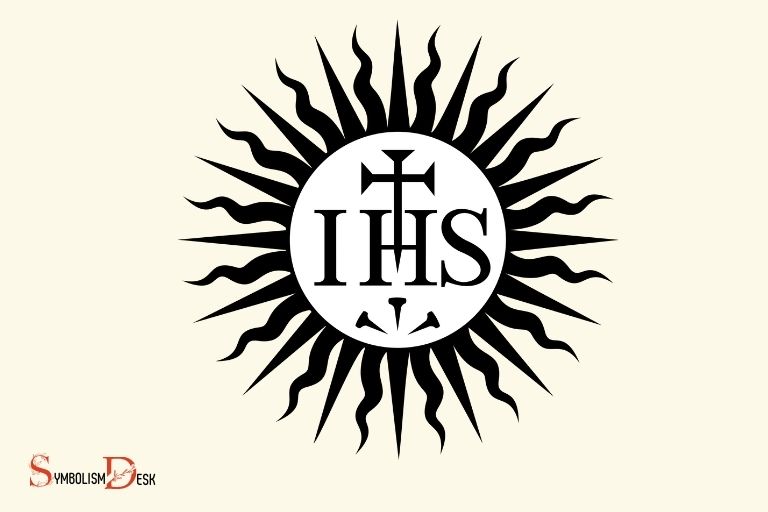What Does the Jesuit Symbol Mean? Society of Jesus!
The Jesuit symbol, also known as the Jesuit emblem, represents the Society of Jesus, a religious order within the Catholic Church founded by St.
Ignatius of Loyola. It features a sun with the letters “IHS” at its center. “IHS” is a Christogram — a combination of letters that forms an abbreviation for the name of Jesus Christ.
The Jesuit symbol holds deep religious significance. The sun represents the light of Christ, illuminating the world with love and truth.
The “IHS” at the center of the sun is derived from the first three letters of Jesus’ name in Greek, ΙΗΣΟΥΣ (Iēsous).
It is an emblem of the passion of Jesus Christ, serving to remind members of the Jesuit order of their commitment to live for God’s greater glory.
The Jesuit symbol not only signifies membership in a particular religious order, but it also serves as a visual manifestation of the Jesuits’ core principles and mission.
The “IHS” and the sun are profound reminders of their commitment to illumination, truth, and service to God’s greater glory. It’s a symbol deeply entrenched in faith, history, and spirituality.
5 Symbols About Meanings of the Jesuit Symbol
| Symbol | Meaning |
|---|---|
| IHS | An acronym derived from the first three letters of Jesus Christ’s name in Greek. It signifies the name of Jesus, and sometimes represented as a monogram. |
| Three Nails | Symbolizes the crucifixion of Jesus Christ. It is a reminder of the passion and suffering of Christ for the salvation of humanity. |
| Sun | The sun represents the Society of Jesus’ worldwide mission and the spiritual illumination brought by the order. |
| Cross | The cross is a universal Christian symbol represents salvation through the crucifixion of Jesus. In the Jesuit emblem, it indicates the order’s devotion to the Christian faith. |
| Thirty-One Rays | Symbolizes the thirty-one original companions of St. Ignatius of Loyola, the founder of the Jesuits. |
Key Takeaway

Five Facts About: The Jesuit Symbol
Defining The Jesuit Symbol: Origins And History
The jesuit symbol is widely recognized as a powerful representation of the jesuit tradition and values.
It is made up of three simple images: the letters “ihs,” a sun, and three nails. Each element of the symbol has its own history and meaning, and when combined, they paint a vivid picture of the jesuit ethos.
The History Of The Jesuits
The jesuits, also known as the society of jesus, are a catholic religious order founded in 1540 by saint ignatius of loyola. They are known for their intellectual rigor, strong missionary spirit, and commitment to social justice and education.
The order quickly spread throughout europe and became known for their role in the counter-reformation.
The Origins Of The Jesuit Symbol
The letters “ihs” have their roots in medieval christianity, where they were used as a shorthand for the name of jesus. Saint ignatius adopted these letters as a symbol of the jesuit spirit and mission.
The sun, which appears behind the letters, has multiple meanings, including representing the dawning of a new era for humanity and the light of christ illuminating the world.
The three nails are a reference to the crucifixion of jesus on the cross.
Explanations Of The Different Parts Of The Symbol
The letters “ihs”: The letters represent the name of jesus in greek (ιησους). These letters have been used in christian symbolism for centuries and have various meanings, such as “iesus hominum salvator” (jesus, savior of humankind) or “in his service”. The letters “ihs”: The letters represent the name of Jesus in Greek (Ιησους). These letters have been used in Christian symbolism for centuries and have various meanings, such as “Iesus Hominum Salvator” (Jesus, Savior of Humankind) or “In His Service.” Over time, they became a significant emblem in Christian art and architecture, often appearing on altars, vestments, and sacred objects. Interestingly, the integration of symbols in religious contexts often invites comparisons to other traditions, such as the hermes symbol meaning explained in spiritual interpretations, which underscores the shared human desire to convey profound truths through symbolic forms. In Christian theology, the “IHS” monogram continues to evoke the centrality of Christ’s role in salvation and devotion.
The letters also represent the jesuit spirit of being “men and women for others.”
The sun: The sun, which appears behind the letters “ihs”, represents the light of christ illuminating the world. It also symbolizes the dawning of a new era for humanity.
The nails: The three nails in the symbol are a reference to the crucifixion of jesus on the cross. They remind us of the suffering of jesus and the sacrifice he made for humanity.
The jesuit symbol has a deep and rich history that reflects the values and mission of the society of jesus. The letters “ihs,” the sun, and the three nails each have their own significance and meaning, which when combined, bring to life the jesuit ethos.
The symbol remains a powerful representation of the jesuit tradition and continues to inspire those who are dedicated to social justice, education, and serving others.
The Complexity Of The Jesuit Symbol: Interpretations And Meaning
Symbolism has been used for centuries to convey meaning and messages to different people. One such symbol is the jesuit symbol, which has been highly debated and discussed over the years.
The jesuit symbol, also known as the “ihs monogram”, comprises many elements that are open to different interpretations.
In this section, we’ll dive deep into the various interpretations of the jesuit symbol, the meaning of its individual elements, and its relevance in modern times.
The Different Interpretations Of The Jesuit Symbol
The jesuit symbol has been interpreted in many ways over the years, and each interpretation is unique in its own way.
Here are a few common interpretations of the jesuit symbol:
- The first interpretation is that ihs stands for “iesus hominum salvator” or “jesus savior of men” in latin, reflecting the primary role of the society of jesus in the service of the catholic church.
- Another interpretation suggests that ihs stands for the first three letters of the greek word for jesus, “ihsous.”
- Some interpret the three nails that pierce the letter “h” as the nails that were used during jesus’ crucifixion.
- Others interpret the rays of light emanating from the letter “h” as a representation of the holy spirit.
The Meaning Behind The Individual Elements Of The Symbol
The jesuit symbol comprises many elements, each with a specific meaning.
Here’s what they represent:
- The letters “ihs” represent the first three letters of the name of jesus in greek.
- The three nails represent the nails that were used to crucify jesus on the cross.
- The rays of light emanating from the letter “h” represent the glory of jesus’ resurrection and the holy spirit.
- The circle surrounding the letters and nails represents the world and the universality of christ’s mission.
The Relevance Of The Symbol In Modern Times
The jesuit symbol continues to be relevant in modern times.
It serves as a reminder of the principles and values that the jesuit order and the catholic church uphold, including:
- Spreading the message and mission of jesus to all corners of the world.
- Serving the marginalized and vulnerable members of society, as jesus did in his time.
- Embracing education and intellectual inquiry, traits that are at the core of jesuit tradition.
The jesuit symbol is a complex symbol that has been interpreted in different ways over the years.
Its individual elements hold significant meaning, and it continues to be relevant in modern times as a symbol of the jesuit order’s mission and values.
The Jesuit Symbol And Christianity: Connection And Significance
The jesuit symbol, also known as the “ihs” monogram, has a vital connection to christianity.
The monogram consists of the letters “ihs,” which is an abbreviation for the greek word “iesus,” translating to “jesus” in english.
Here are some essential points regarding the christian and catholic significance of the jesuit symbol:
The Christian And Catholic Significance Of The Jesuit Symbol
- The jesuit symbol, with its “ihs” monogram, is deeply significant in christianity and catholicism, representing the name of jesus.
- The jesuits strongly believe that the ultimate goal of human life is to serve and glorify god, with the symbol serving as a reminder of god’s message and the power of human compassion and kindness to unearth it.
- The monogram is often depicted with a cross and various other symbols such as a heart, a book, a flame, or a crown with nails. Each symbol comes along with its interpretation but represents specific christian or catholic teachings and values.
How The Jesuit Symbol Represents Jesuit Ideals And Values
- The various symbols in the jesuit monogram symbolize the ideals and values that the jesuits follow, including a deep commitment to their faith, education, and social justice.
- The symbol’s ihs monogram is interpreted as “iesus hominum salvator,” which means “jesus, savior of humanity,” conveying the jesuits’ dedication to service and compassion.
- The symbol’s cross portrays the jesuit’s commitment to following the teachings of jesus christ, with his message of love, hope, and compassion towards all people, regardless of their backgrounds, beliefs, or standing in society.
The Importance Of The Jesuit Symbol In The Jesuit Tradition
- The jesuit symbol is an intrinsic part of the jesuit tradition, representing its values, teachings, history, and mission.
- The jesuit tradition is based on the teachings of st. ignatius loyola, the founder of the society of jesus, who promoted spiritual growth, service, and education as a means to change lives, communities, and the world.
- The jesuit symbol serves as a reminder of the jesuits’ dedication to their mission, their commitment to their faith, and their strong sense of community. It inspires followers to pursue wisdom, knowledge, and compassion, and apply them to the world’s pressing issues.
Overall, the jesuit symbol holds great significance to the jesuits, the catholic church, and christianity as a whole.
Its rich history, teachings, and values continue to inspire and motivate jesuits to serve their faith and communities with love and compassion as they work towards a better world.
Jesuit Symbolism In Art And Architecture
The jesuit symbol, also known as the jesuit emblem or ihs monogram, is a common motif in art and architecture.
Here are some examples of how the jesuit symbol is used in these fields:
- The jesuit symbol often appears in churches, cathedrals, and other religious buildings. It may be carved into woodwork, painted onto walls and ceilings, or incorporated into stained glass windows.
- In art, the jesuit symbol is often used to represent christ as the savior of humanity. It may appear in paintings, sculptures, and other works of religious art.
- Jesuit colleges and universities often use the jesuit symbol as part of their official seals and logos.
Examples Of Jesuit Symbolism In Historical Buildings And Artwork
The jesuit symbol has been used for centuries in art and architecture.
Here are a few notable examples:
The church of the gesù in rome, which was built in the late 16th century and is considered one of the finest examples of baroque architecture, features the jesuit symbol prominently in its design.
The symbol appears in the church’s dome, on the ceiling of the nave, and as part of the altar.
The jesuit church in vienna, which was built in the early 17th century, also features the jesuit symbol prominently in its design. The symbol appears on the church’s façade, in the ceiling frescoes, and on the high altar.
The virgin of the immaculate conception, a painting by bartolomé esteban murillo that is now in the national gallery of art in washington, d.c., features the jesuit symbol in the form of an ihs monogram on the virgin mary’s chest.
The Meaning Behind The Use Of The Jesuit Symbol In Artistic Representations
The jesuit symbol has multiple meanings in artistic representations, including:
- The letters ihs are an abbreviation of the name of jesus in greek (ιησους). They can therefore represent the name of christ and his saving power.
- The symbol can also be interpreted as an abbreviation for the latin phrase iesus hominum salvator, which means “jesus, savior of humanity.”
- In some artistic representations, the jesuit symbol is used to symbolize the jesuit order’s dedication to spreading the gospel and serving the needs of humanity.
Overall, the jesuit symbol plays an important role in both art and architecture, and has rich meanings that reflect the jesuit order’s commitment to christ and humanity.
Are There Similarities Between the Khanda Symbol and the Jesuit Symbol?
The meaning of khanda symbol in sikhism holds great significance, representing various principles like unity, equality, and justice. On the other hand, the Jesuit symbol, while visually distinct, embodies similar notions such as faith, education, and service. Both symbols possess profound spiritual meanings that guide their respective religious communities.
FAQ About What Does The Jesuit Symbol Mean?
What Is The Jesuit Symbol?
The jesuit symbol is a monogram representing the society of jesus’ motto in latin.
What Does The Jesuit Symbol Mean?
The jesuit symbol ihs represents the phrase “iesus hominum salvator” meaning “jesus, savior of mankind. “
What Is The Origin Of The Jesuit Symbol?
The jesuit symbol originates from the society of jesus founded by saint ignatius of loyola in the 16th century.
Why Is The Jesuit Symbol Important?
The jesuit symbol is a significant emblem that reflects the jesuits’ commitment to education, faith, and social justice.
Is The Jesuit Symbol Still Relevant Today?
Yes, the jesuit symbol still holds meaning and inspires jesuits all over the world to follow their motto in serving others.
Conclusion
Exploring the meaning of the jesuit symbol reveals the depth and complexity of the jesuit tradition.
The emblem represents a powerful bond between the disparate elements of the jesuit way of life, ultimately pointing to the order’s central mission of promoting the greater glory of god.
As such, the symbol stands as a unifying presence for all jesuits, signifying their shared values and goals.
Understanding the significance of the different aspects of the emblem — from the letters to the central image to the surrounding motto — requires a nuanced appreciation of the jesuit worldview.
By looking critically at the symbol’s various components, one can gain a better sense of the jesuit approach to the world and their commitment to advancing knowledge, improving society, and fostering spiritual growth.
Ultimately, the jesuit symbol is a testament to the enduring power and resonance of the jesuit philosophy, which continues to inspire individuals and communities around the globe.






